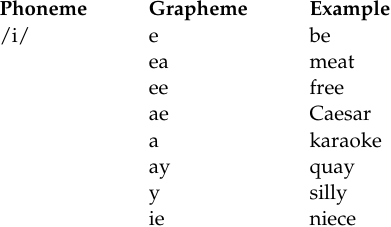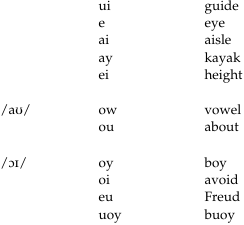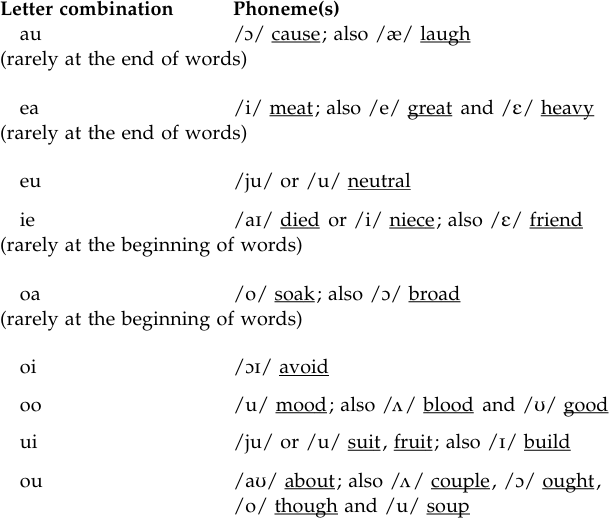


 Grammar
Grammar
 Tenses
Tenses
 Present
Present
 Past
Past
 Future
Future
 Parts Of Speech
Parts Of Speech
 Nouns
Nouns
 Verbs
Verbs
 Adverbs
Adverbs
 Adjectives
Adjectives
 Pronouns
Pronouns
 Pre Position
Pre Position
 Preposition by function
Preposition by function 
 Preposition by construction
Preposition by construction
 Conjunctions
Conjunctions
 Interjections
Interjections
 Grammar Rules
Grammar Rules
 Linguistics
Linguistics
 Semantics
Semantics
 Pragmatics
Pragmatics
 Reading Comprehension
Reading Comprehension|
Read More
Date: 2024-05-22
Date: 2024-03-22
Date: 2024-03-23
|
Phoneme–Grapheme Correspondences in English Vowels
The phoneme-to-grapheme correspondences for the vowels are as follows:




As in the case of the consonants, if we look at the grapheme-to-phoneme relationship of the vowels, we can find more regular correspondences. The five vowel letters and their sound values in monosyllabic words are given as follows:

If the ‘vowel letter’ in a monosyllabic word is followed by a consonant, which is then followed by the letter e at the end of the word, the sound value for the vowel letter is the one given in (1) (the well-known ‘silent e’ rule taught in schools); otherwise, the sound value is the one given in (2).
The situation is more complicated in polysyllabic words. For example, how do we know the sound values of a in mutation and of u in reduction? Both in [mjuteʃən] and in [ɹ̣ədΛkʃən] the stress is on the syllable before the suffix. The rule is first to ignore the ending -ion, and then to count the consonants that follow the vowel letter in question. In mutation, the vowel letter a is followed by a single consonant, and thus the sound value will be the one given in (1), namely /e/ as in [mjuteʃən]. In reduction, the vowel u is followed by two consonants and thus the sound value is the one given in (2), namely /Λ/ as in [ɹ̣ədΛkʃən]. Although this is quite workable, and indeed valid for many words with a suffix with the letter i followed by a vowel and then by anything else (e.g. -ial, -ious, -iary), it is not problem-free. Specifically, there are problems with the letter i in the root. While in submission and addiction, the non-suffixal i is followed by two consonant letters and has the predicted value (2), namely /ɪ/, in revision and provision, it is followed by one consonant letter, but does not have the predicted sound value of (1), /aɪ/, as the pronunciations are [ɹ̣əvɪʒən] and [pɹ̣əvɪʒən]. Unlike the examples discussed here, in some of the examples we looked at earlier, we saw that the vowel letters represented the two possible sounds (i.e. long/short vowels), which cannot be accounted for by the number of following consonants. For example, in pairs such as grateful /e/ - gratitude /æ/, mine /aɪ/ - mineral /ɪ/, the first words have the bold-type focal vowel letter representing the long vowel/diphthong, which is in accordance with expectations because the vowel letter is followed by a single consonant. The second words in these pairs, however, employ short vowels despite the fact that they are followed by a single consonant, and, according to expectations, should employ long vowels.
Besides the single vowel letters, English uses several vowel-letter combinations for certain sound correspondences. The alphabet, which was borrowed from the Romans, provides five vowel letters, i, e, a, o, u, which were sufficient for Latin. However, English has many more vowels, and thus several vowel-letter combinations, called ‘digraphs’, are utilized to meet this demand. The values of the vowel-letter combinations do not change in stressed/unstressed syllables (most common values are given first, and then the secondary values are listed):

We should also mention the letters y and w, which have sound correspondences related to consonants and vowels. We saw earlier that, as syllable onsets (e.g. in yesterday and week), they stand for the glides /j/ and /w/, respectively. The letter y, after a vowel letter, as in ay, ey, uy, oy, stands for /e/ (e.g. day), /i/ (e.g. key), /aɪ/ (e.g. buy), /ɔɪ/ (e.g. boy). The letter w, in the same position, represents /ɔ/ (e.g. saw), /o/ (e.g. sew), and /aʊ/ (e.g. vowel). The letter y, occurring in final position after a consonant, represents /i/ (e.g. happy, baby) or /aɪ/ (e.g. fly, sky), and usually changes to i when a suffix is added (e.g. defy– defiant; duty– dutiful; happy – happiness; lively – livelihood). This change does not apply with a suffix starting with i (to avoid two i’s. Thus, we get baby– babyish, lobby– lobbyist, defy– defying). Finally, when an -s suffix is added, y turns into -ie (e.g. deny – denies; fly– flies). This rule has the following two exceptions: (a) y as part of an oy, ay, ey combination (e.g. employ– employs; obey– obeys), and (b) -s as the possessive suffix (e.g. Tommy’s, anybody’s).
|
|
|
|
للعاملين في الليل.. حيلة صحية تجنبكم خطر هذا النوع من العمل
|
|
|
|
|
|
|
"ناسا" تحتفي برائد الفضاء السوفياتي يوري غاغارين
|
|
|
|
|
|
|
المجمع العلمي يقيم ورشة تطويرية ودورة قرآنية في النجف والديوانية
|
|
|